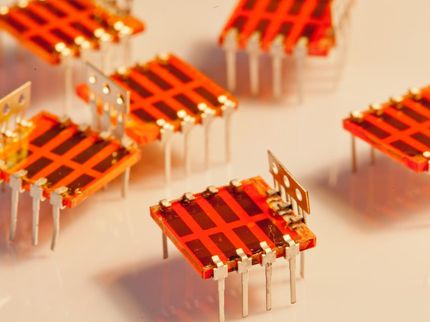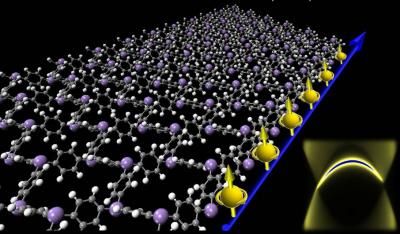Persuading light to mix it up with matter
Researchers at MIT have succeeded in producing and measuring a coupling of photons and electrons on the surface of an unusual type of material called a topological insulator. This type of coupling had been predicted by theorists, but never observed.
The researchers suggest that this finding could lead to the creation of materials whose electronic properties could be "tuned" in real time simply by shining precise laser beams at them. The work "opens up a new avenue for optical manipulation of quantum states of matter," says Nuh Gedik, the Lawrence C. (1944) and Sarah W. Biedenharn Associate Professor of Physics and senior author of a paper published in Science.
Gedik, postdoc Yihua Wang (now at Stanford University), and two other MIT researchers carried out the experiments using a technique Gedik's lab has been developing for several years. Their method involves shooting femtosecond (millionths of a billionth of a second) pulses of mid-infrared light at a sample of material and observing the results with an electron spectrometer, a specialized high-speed camera the team developed.
They demonstrated the existence of a quantum-mechanical mixture of electrons and photons, known as a Floquet-Bloch state, in a crystalline solid. As first theorized by Swiss physicist Felix Bloch, electrons move in a crystal in a regular, repeating pattern dictated by the periodic structure of the crystal lattice. Photons are electromagnetic waves that have a distinct, regular frequency; their interaction with matter leads to Floquet states, named after the French mathematician Gaston Floquet. "Entangling" electrons with photons in a coherent manner generates the Floquet-Bloch state, which is periodic both in time and space.
The researchers mixed the photons from an intense laser pulse with the exotic surface electrons on a topological insulator. Their high-speed camera captured snapshots of the exotic state, from its generation to its rapid disappearance, a process lasting only a few hundred femtoseconds. They also found there were different kinds of mixed states when the polarization of the photons changed.
Their findings suggest that it's possible to alter the electronic properties of a material — for example, changing it from a conductor to a semiconductor — just by changing the laser beam's polarization. Normally, to produce such dramatic changes in a material's properties, "you have to do something violent to it," Gedik says. "But in this case, it may be possible to do this just by shining light on it. That actually modifies how electrons move in this system. And when we do this, the light does not even get absorbed."
In other situations, light can modify a material's behavior — but only when it's absorbed, transferring its energy to the material. In this experiment, Gedik says, the light's energy is below the absorption threshold. This is exciting, he says, because it opens up the possibility of switching a material's behavior back and forth without inducing other effects, such as heating — which would happen if the light were absorbed.
It will take some time to assess possible applications, Gedik says. But, he suggests, this could be a way of engineering materials for specific functions. "Suppose you want a material to do something — to conduct electricity, or to be transparent, for example. We usually do this by chemical means. With this new method, it may be possible to do this by simply shining light on the materials."
For example, a property called a bandgap — a crucial characteristic for materials used in computer chips and solar cells — can be altered by shining a polarized laser beam at the material, Wang says. "You can directly change it, open the bandgap, just with light. It means you can change it from a metal to a semiconductor, for example," he says.
Gedik says that while this experiment was done using bismuth selenide crystals, a basic topological insulator, "what we have done is not specific to topological insulators. It should also be realizable in other materials as well, such as graphene."
Most read news
Other news from the department science

Get the chemical industry in your inbox
By submitting this form you agree that LUMITOS AG will send you the newsletter(s) selected above by email. Your data will not be passed on to third parties. Your data will be stored and processed in accordance with our data protection regulations. LUMITOS may contact you by email for the purpose of advertising or market and opinion surveys. You can revoke your consent at any time without giving reasons to LUMITOS AG, Ernst-Augustin-Str. 2, 12489 Berlin, Germany or by e-mail at revoke@lumitos.com with effect for the future. In addition, each email contains a link to unsubscribe from the corresponding newsletter.


























































